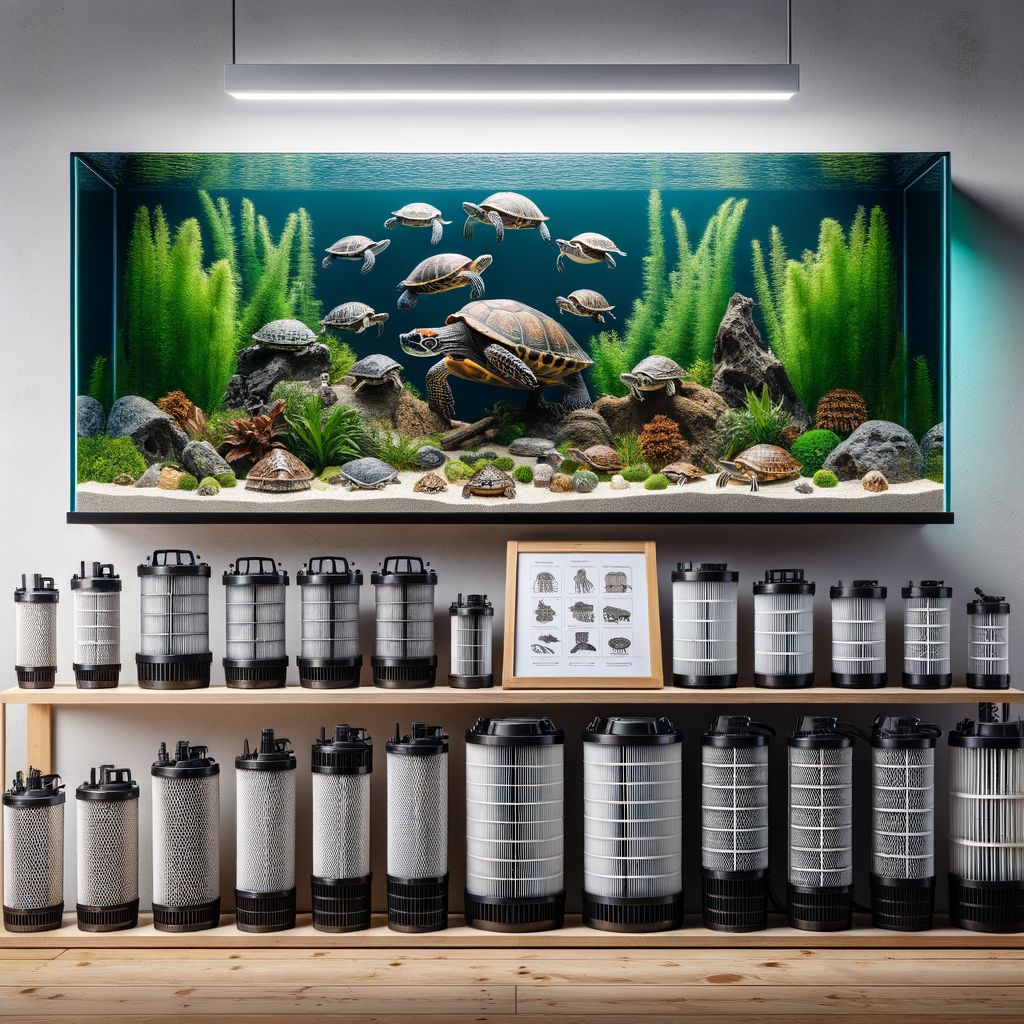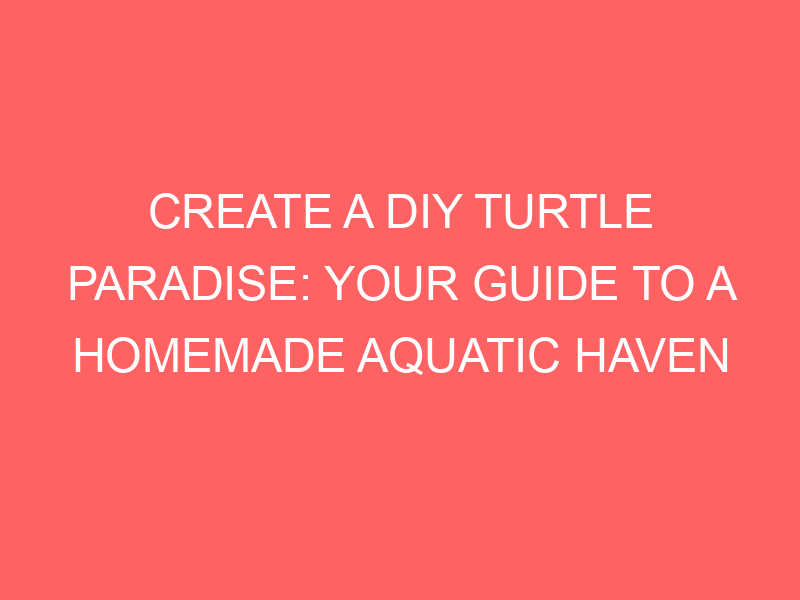
Introduction to Mid-sized Turtle Tanks
When it comes to providing a comfortable and healthy environment for your pet turtle, the size of the tank plays a crucial role. This article will introduce you to the concept of mid-sized turtle tanks, specifically focusing on the 50-gallon variety, and the benefits they offer.
- Understanding the Importance of Size in Turtle Tanks
- Why 50-Gallon Turtle Tanks are Considered Mid-Sized
- Benefits of Mid-Sized Turtle Tanks
Size is a significant factor when choosing a turtle tank. Turtles need enough space to swim, bask, and hide. A tank that’s too small can lead to stress, health issues, and stunted growth in turtles. On the other hand, a tank that’s too large can make it difficult for the turtle to find its food and basking spots, and can be challenging to clean and maintain.
When we talk about mid-sized turtle tanks, we typically refer to tanks that hold around 50 gallons of water. These tanks are considered mid-sized because they provide a balance between space and manageability. They offer ample room for a turtle to swim and bask, yet they’re not so large that they become difficult to clean or take up too much space in your home.
Mid-sized turtle tanks, like the 50-gallon variety, come with several benefits. They provide enough space for your turtle to live comfortably, without taking up too much room in your home. They’re also easier to clean and maintain than larger tanks. Additionally, mid-sized tanks are often more affordable than larger ones, making them a great choice for turtle owners on a budget.
In conclusion, a mid-sized turtle tank can provide a comfortable and healthy environment for your pet turtle. It offers the right balance between space and manageability, making it an excellent choice for both you and your turtle.
Understanding Turtle Habitat Requirements
When it comes to the well-being of your pet turtle, understanding their habitat requirements is crucial. In this section, we will delve into the specifics of setting up an indoor turtle tank, which is a popular choice for many turtle owners.
Indoor Turtle Tank Setup
Setting up an indoor turtle tank requires careful planning and attention to detail. It involves more than just filling a tank with water. Let’s explore the essential components and how to create a natural habitat within an indoor turtle tank.
- Essential components of an indoor turtle tank
- Tank Size: The tank should be large enough for your turtle to swim and move around comfortably. A good rule of thumb is 10 gallons of water per inch of turtle.
- Water Quality: Turtles need clean water to thrive. A good filtration system is crucial to maintain water cleanliness and prevent the buildup of harmful bacteria.
- Heating and Lighting: Turtles are cold-blooded animals and need a heat source to regulate their body temperature. They also require UVB light for vitamin D production.
- Basking Area: Turtles need a dry area where they can bask under a heat lamp. This area should be easy for the turtle to climb onto and large enough for it to fully dry off.
- Creating a natural habitat within an indoor turtle tank
- Use Natural Substrates: Sand, pebbles, or aquatic plants can mimic the natural environment of a turtle and provide stimulation.
- Provide Hiding Spots: Turtles, like many animals, appreciate having a place to hide. This can be achieved with the use of rocks, caves, or even PVC pipes.
- Keep the Environment Dynamic: Changing the layout of the tank or introducing new objects can keep your turtle engaged and curious.
There are several key elements to consider when setting up an indoor turtle tank:
Creating a natural habitat within an indoor turtle tank can greatly enhance your turtle’s quality of life. Here are some tips:
In conclusion, setting up an indoor turtle tank involves careful consideration of the tank’s components and creating a natural, stimulating environment. By understanding these requirements, you can ensure your turtle thrives in its new home.
Aquatic Turtle Tank Setup
Setting up a turtle tank is an essential step in ensuring the health and happiness of your pet. However, it’s important to note that the setup for an aquatic turtle tank differs significantly from that of a terrestrial turtle tank. Let’s explore these differences and the key elements you need to consider when setting up an aquatic turtle tank.
- Key Differences Between Aquatic and Terrestrial Turtle Tanks
- Essential Elements of an Aquatic Turtle Tank Setup
Aquatic turtles, as their name suggests, spend most of their time in water. Therefore, their tanks need to be filled with enough water for them to swim and dive. On the other hand, terrestrial turtles, also known as tortoises, spend most of their time on land, so their tanks require less water and more dry land area.
Another key difference lies in the heating and lighting requirements. Aquatic turtles need both a basking area with a heat lamp and a UVB light to mimic the sun’s rays. Terrestrial turtles, on the other hand, can often get by with just a heat lamp, as they get most of their UV exposure from natural sunlight.
When setting up an aquatic turtle tank, there are several key elements you need to consider:
| Element | Description |
|---|---|
| Water Area | This should be deep enough for your turtle to swim and dive comfortably. |
| Basking Area | A dry area where your turtle can bask under a heat lamp. |
| Heat Lamp | Provides the warmth your turtle needs to regulate its body temperature. |
| UVB Light | Mimics the sun’s rays, providing your turtle with necessary UVB radiation. |
| Filter | Keeps the water clean and free from harmful bacteria. |
Remember, each turtle species has its own specific needs, so always research and consult with a professional before setting up your turtle tank.
Choosing the Best Turtle Tank Filters
When it comes to creating the perfect environment for your turtle, one of the most important components is the turtle tank filter. Let’s delve into why filters are so crucial in a turtle tank.
Importance of Filters in a Turtle Tank
Filters play a vital role in maintaining a clean and healthy habitat for your turtle. They are not just a luxury, but a necessity. Here’s why:
- Role of filters in maintaining a clean turtle habitat
- Impact of filters on the health and longevity of turtles
A turtle tank filter helps keep the water clean by removing waste, uneaten food, and other debris. This helps prevent the buildup of harmful bacteria and algae, which can make the water murky and unhealthy for your turtle. Without a filter, you would need to change the water frequently, which can be stressful for your turtle and time-consuming for you.
Filters not only keep the water clean, but they also help to maintain the right balance of chemicals in the water. This is crucial for the health and longevity of your turtle. A good filter can help prevent common health problems in turtles, such as shell rot and respiratory infections. In fact, turtles in well-filtered tanks tend to live longer and healthier lives.
In conclusion, a good filter is an essential part of a turtle tank. It helps maintain a clean and healthy environment for your turtle, contributing to its overall well-being and longevity. So, when setting up your turtle tank, don’t overlook the importance of choosing the best filter.
Top Turtle Tank Filters for 50-Gallon Tanks
Choosing the right filter for your 50-gallon turtle tank is crucial. It ensures the water remains clean and healthy for your pet turtle. Let’s dive into the top-rated filters suitable for 50-gallon tanks and compare them to help you make the best choice.
-
Review of Top-Rated Filters Suitable for 50-Gallon Tanks
-
Comparative Analysis of the Best Turtle Tank Filters
- Efficiency: All three filters offer efficient filtration. However, Filter A and B have a slight edge due to their high flow rate and multi-stage filtration, respectively.
- Noise Level: If you prefer a quiet environment, Filter B would be the best choice as it operates silently.
- Price: If budget is a concern, Filter C offers a great balance between cost and performance.
Here are some of the best filters for 50-gallon turtle tanks:
| Filter Name | Key Features | Price Range |
|---|---|---|
| Filter A | High flow rate, easy to clean, energy efficient | $$ |
| Filter B | Quiet operation, durable, multi-stage filtration | $$$ |
| Filter C | Compact design, powerful filtration, affordable | $ |
Each of these filters has its strengths. Filter A is known for its high flow rate and energy efficiency, while Filter B stands out for its quiet operation and durability. Filter C, on the other hand, offers a compact design and powerful filtration at an affordable price.
When comparing these top-rated filters, it’s important to consider your specific needs and budget. Here’s a quick comparison:
Remember, the best filter for your turtle tank depends on your specific needs and circumstances. Always consider factors such as the number of turtles, their size, and the overall tank setup when choosing a filter.
Turtle Tank Maintenance
Keeping your turtle’s tank clean and well-maintained is crucial for the health and happiness of your pet. This section will guide you through the process of regular cleaning and filter replacement.
Regular Cleaning and Filter Replacement
Regular cleaning and filter replacement are two key aspects of turtle tank maintenance. Let’s delve into why they are important and how to perform these tasks effectively.
- Importance of regular tank cleaning
- Steps to replace and maintain turtle tank filters
- Turn off and unplug the filter.
- Remove the filter from the tank and disassemble it according to the manufacturer’s instructions.
- Replace the filter media with new ones. Be sure to use the type recommended by the filter manufacturer.
- Reassemble the filter and place it back in the tank.
- Plug the filter back in and turn it on. Check to make sure it’s working properly.
Cleaning your turtle tank regularly is essential for several reasons. Firstly, it prevents the build-up of harmful bacteria and algae, which can negatively impact your turtle’s health. Secondly, a clean tank is more visually appealing and provides a more natural and comfortable environment for your turtle. Lastly, regular cleaning can extend the lifespan of your tank and its equipment.
Replacing and maintaining the filters in your turtle tank is a straightforward process. Here are the steps:
Remember, the filter should be cleaned every month and the filter media should be replaced every three months. This will ensure the filter operates at peak efficiency and keeps your turtle’s water clean and healthy.
In conclusion, regular cleaning and filter replacement are essential tasks in turtle tank maintenance. By following these steps, you can provide a clean, healthy, and comfortable environment for your turtle.
Monitoring Turtle Health
Keeping your turtle healthy is a vital part of turtle tank maintenance. Let’s take a look at some key signs of a healthy turtle habitat and common health issues that can arise if the tank is not properly maintained.
- Signs of a Healthy Turtle Habitat
- The water in the tank is clear and doesn’t have a foul smell.
- The turtle is active and shows a healthy appetite.
- The turtle’s shell is firm and free from cracks or discoloration.
- The turtle’s eyes are clear and bright, without any discharge.
- Common Health Issues in Turtles and Their Relation to Tank Maintenance
- Shell Rot: This is a fungal or bacterial infection that affects the turtle’s shell. It is often caused by dirty water or a poorly maintained habitat.
- Respiratory Infections: Turtles can develop respiratory infections if they are kept in a tank with poor ventilation or if the water temperature is too low.
- Eye Infections: These are usually caused by poor water quality or a lack of vitamin A in the turtle’s diet.
A healthy turtle habitat is clean, well-maintained, and free from harmful substances. Here are some signs of a healthy turtle habitat:
Improper tank maintenance can lead to several health issues in turtles. Some of the common health problems include:
Regular tank cleaning and filter replacement can help prevent these health issues and ensure your turtle stays healthy.
Remember, a healthy turtle is a happy turtle. By monitoring your turtle’s health and maintaining its habitat, you can ensure your pet lives a long, happy life.
Conclusion: Creating the Ideal Environment for Your Turtle
As we wrap up our discussion on mid-sized turtle tanks, it’s important to remember that creating the perfect environment for your turtle goes beyond just buying a tank. It’s about understanding your turtle’s habitat requirements, choosing the right filters, and maintaining the tank properly. Let’s recap some of the key points we’ve covered.
- Recap of the importance of proper tank setup and maintenance: Setting up your turtle’s tank correctly is crucial. It should mimic their natural habitat as closely as possible, with the right amount of water, a basking area, and suitable lighting. Regular maintenance is equally important. This includes cleaning the tank, changing the water, and checking the filter regularly. Remember, a clean and well-maintained tank is a healthy environment for your turtle.
- Final thoughts on choosing the best filters for a 50-gallon turtle tank: The filter is an essential part of your turtle’s tank. It helps keep the water clean and safe for your turtle. For a 50-gallon tank, you need a filter that can handle the load. It should be efficient, easy to clean, and quiet. There are many options available in the market, but always choose one that best suits your turtle’s needs.
In conclusion, creating the ideal environment for your turtle is a responsibility that should be taken seriously. It requires time, effort, and a good understanding of your turtle’s needs. But the reward is worth it. A happy, healthy turtle is a joy to have around. So, take the time to set up and maintain your turtle’s tank properly. Your turtle will thank you for it.














